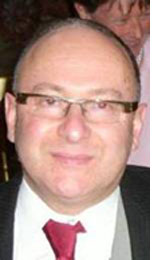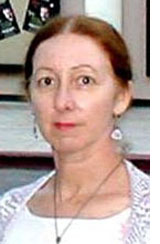

THE VIEW FROM JINSA
National borders ignored by terrorists
By Shoshana Bryen
 WASHINGTON, D.C.—One of the clearest asymmetries in the war against terrorists and the states that harbor and support them is that Western countries believe borders are sacrosanct, while terrorists and their sponsors do not. Syria and Iran supply Hezbollah across the Lebanon border. The PKK crosses from Iraq into Turkey. Hamas shoots rockets at Israel and smuggles arms from Egypt. Syria, Iran and Saudi Arabia have all permitted irregular forces to cross from their countries into Iraq. Taliban and al Qaeda cross into Afghanistan from Pakistan. Efforts at defense against these incursions are internationally suspect and retaliation generally condemned, at least by the UN. WASHINGTON, D.C.—One of the clearest asymmetries in the war against terrorists and the states that harbor and support them is that Western countries believe borders are sacrosanct, while terrorists and their sponsors do not. Syria and Iran supply Hezbollah across the Lebanon border. The PKK crosses from Iraq into Turkey. Hamas shoots rockets at Israel and smuggles arms from Egypt. Syria, Iran and Saudi Arabia have all permitted irregular forces to cross from their countries into Iraq. Taliban and al Qaeda cross into Afghanistan from Pakistan. Efforts at defense against these incursions are internationally suspect and retaliation generally condemned, at least by the UN.
South of our border, terrorist organizations and state sponsors combine in places with weak governments. A variety of Islamist organizations, including Hamas and Hezbollah, are active the in the uncontrolled area between Argentina, Brazil and Paraguay known as the Tri-Border Area. Venezuela has given identity documents that can be used for Venezuelan passports and even American visas to people from Syria, Pakistan, Egypt and Lebanon. Saudi Arabia finances the construction of mosques and Islamic centers in several countries. Free trade zones make travel between countries easy.
Not all of the mess is related to Middle Eastern activities. Democratic Colombia has been plagued for years by FARC, a vicious drug cartel dealing in kidnapping and massacres of civilian opponents. Designated a terrorist organization by the United States and Europe, FARC had based one of its top commanders in neighboring Ecuador.
Colombia struck back this weekend - killing a top FARC commander and about 20 of his operatives in a raid on a base about a mile inside Ecuador. No Colombian forces remained in Ecuador after the raid. The Washington Post reported:
Senior Colombian officials say a laptop recovered at the FARC camp contained evidence that Mr. Chávez had recently given the group $300 million and had financial links with the terrorists dating to his own failed coup against a previous Venezuelan government in 1992. Colombia said Mr. Correa's government (Ecuador) had been negotiating with Mr. Reyes (the FARC commander) about replacing Ecuadorian military officers who might object to his use of the country as a base. In other words, both Mr. Correa and Mr. Chávez were backing an armed movement with an established record of terrorism and drug trafficking against the democratically elected government of their neighbor.
That makes Venezuela and Ecuador state sponsors of terrorism in our book, providing the attributes of statehood to non-state actors. They should be no more immune from retaliation than Iran, Syria, Pakistan or the Palestinian Authority should be.
Unfortunately, The Organization of American States yesterday denounced Colombia's defense against the FARC, calling the raid, "a violation of the sovereignty and territorial integrity of Ecuador and of principles of international law." The OAS has learned nothing from the Middle East's experience with transnational terrorism. It is Ecuador that permitted the violation of Colombia's sovereignty, and Ecuador that must either fix the problem or expect the legitimate response of a country that declines to be the victim.


THE HISTORY MAN
Will Jewish woes in UK spread to US?
By Lloyd Levy
 LONDON—Is the problem facing UK Jewry going to happen to Jews in the U.S. in the future ? LONDON—Is the problem facing UK Jewry going to happen to Jews in the U.S. in the future ?
There appears to be a belief in USA, that the UK education system is refusing to teach the Holocaust, due to Muslim pressure. There may be some truth in this, but it is almost certainly not official government policy- more a question of some local education board initiatives. The current Prime Minister Gordon Brown, and his predecessor Tony Blair, are both extremely pro-Jewish.
Nevertheless, in my personal opinion, the average British Jew certainly does feel under serious threat, and regards the future with some apprehension. I have never known a situation where so many Jews are buying properties in Israel, as a future escape route. South Netanya is a firm favourite, although mine is in the Negev (you can't escape much further than that !!).
I think we all fear the Islamisation of Europe, and have great anxiety for the future of our children. There are nowadays only approx 250,000 Jews in UK, with numbers having fallen by half in the last 60 years or so, due to low birth rate and intermarriage. Jewish communities of significant size only exist in maybe four cities. Compare this to the Muslim population, which is at least 2 million, and even that is probably an underestimate, because the British Government has had no effective control over immigration. So there are eight times more Muslims than Jews in UK, and one doesn’t have to be a genius to realise who many politicians pander to, in order to get votes.
Combined with this, is a virulent anti-Israel bias in most of the national newspapers, and even more so the BBC (although I feel they are recently trying to be slightly more “balanced”.)
There is an ongoing battle with elements of the Trade Union movement and others on the“left”, to prevent them trying to impose a boycott of Israeli goods. Sadly, many of these anti-Israel movements are led by “Jews.”
Have no doubt about it, these matters do have the effect of undermining Jewish self confidence. Its not a question of physical attacks on Jews, or anything as overt as that, but more of being intimidated and cowered. We do not have the robust Communal leadership in UK that there is in the USA, so we feel very vulnerable to events outside our control.
Is it perhaps not beyond the realm of possibility that in future years we will witness a similar situation developing in USA?. Will future U.S. governments and politicians be as pro-Israel as they have been in the past? And will Jewish opposition to any anti-Israel policies then put American Jewry in conflict with the majority population ? Can American Jews really be sure they can avoid in future years what we are facing now ?
Comments to the editor on this issue are welcome at sdheritage@cox.net


Hillary in 2008, Barack in 2016
By J. Zel Lurie
 DELRAY BEACH, Florida—A couple of weeks ago I had lunch with publisher emitus Bruce Warshal at the local Holiday Inn. DELRAY BEACH, Florida—A couple of weeks ago I had lunch with publisher emitus Bruce Warshal at the local Holiday Inn.
Bruce mentioned my column a month ago in which I brashly said that Hillary Clinton would “edge out” Barak Hussein Obama. She would be our first woman president.
My forecast was quickly followed by a series of Obama victories in one small state after another. The Clinton victories in New York, Massachusetts, California and other large states were forgotten. To Obama supporters like Rabbi Warshal, the Obama momentum would lead to an inevitable nomination and victory in the election.
“Are you going to write a mea culpa?” Bruce asked me.
“Let’s see how she does in Ohio and Texas” I hedged.
The results are in. She beat the pants off Obama in Ohio, In Texas she edged him out. She won Rhode Island by a wide margin and he did the same in Vermont. In Wyoming earlier this week, he won.
Her victory speech in Ohio overwhelmed me. We have had enough of promises, we need solutions, she proclaimed. We need to end the war in Iraq and win the war in Afghanistan.
“Yes we will,” shouted the crowd, a better slogan than Obama’s yes we can.
We need to see to it that every man, woman and child has medical care, she went on. She has not adopted the slogan “Medicare for all.” Not yet, anyway. It would end the hegemony of insurance companies, who are siphoning off an overhead that amounts to one-third of the billions spent on health care and much of it goes to employees whose job is to find ways to deny insurance coverage to patients.
John McCain, the Republican come-back kid, sewed up his nomination last Tuesday. He devoted his victory speech to patriotic rhetoric. I have the feeling that he’s a good man in the wrong party. I’m probably wrong.
Obama’s speech last Tuesday evening lacked Hillary’s fervor. Once again, as he has done numerous times on the campaign trail, he told the story of the boy from Kenya who aspired to be president of the United States. He talked of health care but he knows that his plan will not provide universal coverage.
I have a suggestion to both Hillary and Obama. In your campaign speeches, talk abut bringing peace to Israel and Palestine, which only the United States can do.
Get a hold of the book Negotiating Arab-Israel peace: American Leadership in the Middle East by Daniel C. Kurtzer and Scott B. Lazensky, which will be unveiled in a ceremony at the United States Institute for Peace in Washington.
This slim book is the product of an 18-month study by a group of five professors under the auspices of the Peace Institute. It was led by Kurtzer, who is the former American Ambassador to both Egypt and Israel. Its main point is that, unlike George Bush, who spent eight years neglecting the matter, and Bill Clinton, who worked at it intensively only in the last few months of his reign, the next president must make peace in Jerusalem a priority in his/her inaugural address.
While Kurtzer has been advising Obama, Hillary is more apt to follow his advice in her campaign for nomination. She goes into detail and talks substance and solutions.
The book says that the next president must make clear that an Israeli-Palestinian settlement is of vital national interest. The United states is not doing favors.
The next president must develop a just and fair policy, get the agreement of the parties and count on our envoys to see to it that the parties implement what they have agreed to. As we all know, the latter has been the chief failure of past agreements.
A special envoy might be needed, but the study found that with the president enunciating a fair and just policy a special envoy could be superfluous. “Better a policy without an envoy than an envoy without a policy,” says Kurtzer.
If a special presidential envoy is needed, Hillary could not do better than to call Princeton University for Obama advisor Amb. Daniel Kurtzer.
Hillary is ready for the White House phone to ring at 3 a.m. with a crisis that needs an immediate decision. Obama will be ready in 2016 after another eight years as Senator or a post in the Clinton government, like Secretary of State.


 
(Dale Stokes photos)
Reflections
City Ballet of S.D. records a milestone
By Sheila Orysiek
 SAN DIEGO—As I watched City Ballet of San Diego perform Act II of the ballet La Bayadere, (choreography: M. Petipa) on March 9 it reminded me of the interview with Artistic Director Steven Wistrich in which he told me that for his Bar Mitzvah he was taken to New York City to see his first show on Broadway and fell in love with dance. The second act of La Bayadere is much like a Bar/Bat Mitzvah for a company - a coming of age - a test - an important accomplishment. SAN DIEGO—As I watched City Ballet of San Diego perform Act II of the ballet La Bayadere, (choreography: M. Petipa) on March 9 it reminded me of the interview with Artistic Director Steven Wistrich in which he told me that for his Bar Mitzvah he was taken to New York City to see his first show on Broadway and fell in love with dance. The second act of La Bayadere is much like a Bar/Bat Mitzvah for a company - a coming of age - a test - an important accomplishment.
Though the names of the principal dancers head a company’s roster, a ballet company as an artistic entity is not judged by the principal dancers but by the quality of the corps de ballet. Only by nurturing that entity, shaping it to fit the vision of the artistic director, do the ingredients for a worthy corps de ballet - and therefore a company - become a reality. It can be affirmatively argued that developing this aspect of a company is the most difficult of the challenges facing an artistic director; one can hire a principal dancer to come in as a guest, but not a corps de ballet - that must be a resident component. Principals come and go - but the corps de ballet is truly the living soul of a company.
Of the classical ballets which test this concept La Bayadere is surely one of the most difficult. Act II, Kingdom of the Shades, is the supreme test for the corps de ballet - they are the undisputed stars. Over and again they repeat the same slow enchainement (dance sequence) and while each of the dancers enters individually, she immediately becomes part of the whole. And as a single whole they move. One hand out of place, one head held at a slightly different angle, one leg one inch higher - and the body is fragmented.
The second act in this full length ballet is a vision in the drug induced dream of Prince Solor, and it must drug us, too - mesmerize us - completely; or it fails. For any ballet company to undertake this is a forbidding challenge; the ultimate test of the corps de ballet and therefore of the vision - and ability - of the artistic director. Though City Ballet did not use the traditional ramp upon which the dancers come into view - it is not mandatory - they fulfilled the requirements of style and design.
As each dancer stretches forward into arabesque allongé the skirt of her classical tutu tips up and lined rank on rank, the costumes thus become part of the choreography - a further test of the exactitude demanded. But the most difficult test comes in absolute stillness - when each dancer stands in a simple arabesque, holding the balance while flat in her pointe shoe; against all odds of natural balance, without moving, for what must seem like an eternity. The observer is treated to the quiet sculpted beauty that hidden strength provides - it’s probably one of the most technically naked moments in ballet’s repertoire. Conversely, when all the dancers were executing sequential entrechat (jumped beats) it was quite wonderful to see twenty pairs of legs doing this - all off the floor at the same moment, every foot fully stretched - equal in time, equal in energy.
In each of these tests - moving and still - the corps de ballet of this company has much upon which to congratulate itself. Let’s hope the sixteen members of the corps grow to twenty four - there’s no reason why not - the artistic vision is there. The pas de trois danced by Alexis Risi, Shannon Stobbe, Kate Spaulding, each brought gifts to her variation. Risi was a pleasure. Stobbe was especially sprightly. Spaulding had the daunting task of accomplishing a pirouette from a dead stop fifth position - probably the most difficult of the positions from which to impel into a rotation. Though she did well, it helps when the core is more totally engaged from the previous pas, which lessens the hesitation before the pirouette. The step before the pirouette is the preparation for the pirouette - there is no “rest” between.
Janica Smith and Taurean Green danced the pas de deux with aplomb. Her lines were never exaggerated (there is all too much of this in the ballet world); she respects the classic milieu, and thus she transmits its beauty through her movement. Her grand jeté entournant entrelacé (tour jeté - jumped turn, split) was as light as thistledown with a lovely spring into the rest of the enchainement. Green captures the stage. He uses the music - he breaths it - and so he becomes it. He dances through the music, retards, and then nails it.
In the past couple of years this company has shown it has the talent in the principal rank to dance what it will, now it can be said it has the corps the ballet to lay claim to full maturity. Until that happens no company truly exists. City Ballet of San Diego truly exists, not only as a collection of individuals, but as a body of dance.
The real jewel in this company’s crown is not seen on stage; but her hand is everywhere: resident choreographer Elizabeth Wistrich. To be able to call on this kind of talent, to have it close to hand, is a blessing other companies can only dream about. Her production of Carmina Burana is a test of another kind. It premiered in 1984, but this is the first time City Ballet has performed it. It is a lengthy work using Carl Orff’s powerful music which could easily overwhelm a lesser choreographic talent or lesser dancers. But the dancers were ready - nurtured - carefully grown into undertaking an opus such as this.
The choreography is never inventive for its own sake - it doesn’t obviously “do what the music says” but it always serves the music; showing other ways and windows into it. Pirouettes have meaning - not just a showcase for rotating in space. Intricate petit allegro, often sadly neglected by other choreographers for tricks of the trade, are happily explored by Wistrich. She uses the full stage, doesn’t allow her dancers to overstay, connects the parts and then erases the seams. Her movement flows, is never there to push virtuosity - its organic to the music. Sometimes she splits her groups - each doing something different to the same music and so we get to see two visions of it. And both look right.
My only complaint - though the costumes were interesting, flowing, and at times brilliant reds - they were also at times too muted against a dark background. When a costume designer thinks “black” and the stage is less than fully lit - the designer should think again. Now that I’ve dispensed with my curdled complaint - the rest is cream.
The company fields a stage of exemplary men, but again in Carmina Burana, Taureen Green caught my eye with his sense of musicality. And here I need to emphasize that all the men are a pleasure to watch; each is a distinct personality - moving with power and conviction.
And now to the problem…..in Carmina Burana there were so many dancers, and it was so well done, I’d have to name all of them. Led by Tara Formanck, Ariana Samuelsson and Janica Smith, everyone contributed in full measure and was part of the success.
I’m looking forward to watching this company grow even more - how exciting.
The music for both ballets was taped; Carmina Burana on the brink of aural discomfort.
SAN DIEGO JEWISH WORLD THE WEEK IN REVIEW
Donald H. Harrison in Poway, California: Ner Tamid celebrates renewed unity at 'Night at the Kasbah'
Natasha Josefowitz in La Jolla, California: The nail that gets hammered down first
Sheila Orysiek in San Diego: Contemplating time travel from the San Diego Library's rare book room
Judy Lash Balint in Jerusalem: Mercaz Harav central to Israeli life
Shoshana Bryen in Washington, D.C.: Shootings should end the 'Peace Process'
Carol Davis in San Diego: Snobs eschew The American Plan
Peter Garas in Canberra, Australia: Hey mate, opportunity in Australia
Donald H. Harrison in San Diego: Shor, 6, meets His Honor, The Mayor
Rabbi Baruch Lederman in San Diego: Some thoughts for those at a shiva
Dov Burt Levy in Salem, Massachusetts: Barack Obama, political nudniks and me
Rabbi Leonard Rosenthal in San Diego: The unending need for tzedakah
Shoshana Bryen in Washington, D.C.: Question to Olmert: Is Bush agenda yours?
Rabbi Yeruchem Eilfort in Carlsbad, California: Pain of Jerusalem murders is white hot
Lloyd Levy in London: Museum tablet corroborates Jeremiah
Sheila Orysiek in San Diego: The Sabbath’s Omnipotent Painter
Rabbi Peter Tarlow in College Station, Texas: Huánuco, Peru, is planning for March 14 its first Jewish service in over a century
Sherry Berlin in San Diego: Sarah laughs...and Sammy enjoys Shavuot
Donald H. Harrison in San Diego: Mafia 'wise guy' converts to Judaism
Sheila Orysiek in San Diego: Choreographer seeks to
decentralize dance
from New York City, make it more eclectic
Carol Davis in San Diego: The Clean House plays to a pleased house
Peter Garas in Canberra, Australia: Double standard: journalists shed no tears for Ukrainians denied Russian heating oil
Yvonne Greenberg in San Diego: Lecturer says Sydney Taylor’s children’s books intrigue audiences of all ages
Donald H. Harrison in San Diego: The Zoo as textbook for religious studies
heila Orysiek in San Diego: Kaballah book helps open ears to the Voice
Marissa Palin in San Diego: Beth Israel event focuses on auto emissions
Gary Rotto in San Diego: Surrogates for Clinton and Obama debate for the affection of Ohio Jewish voters
Lynne Thrope in La Jolla, California: Whisknladle: restaurant gets it right
Link to previous editions
< BACK TO TOP
|

 —
—